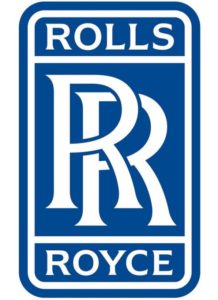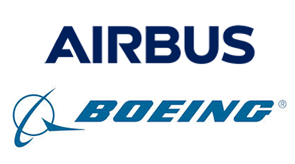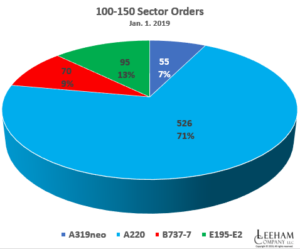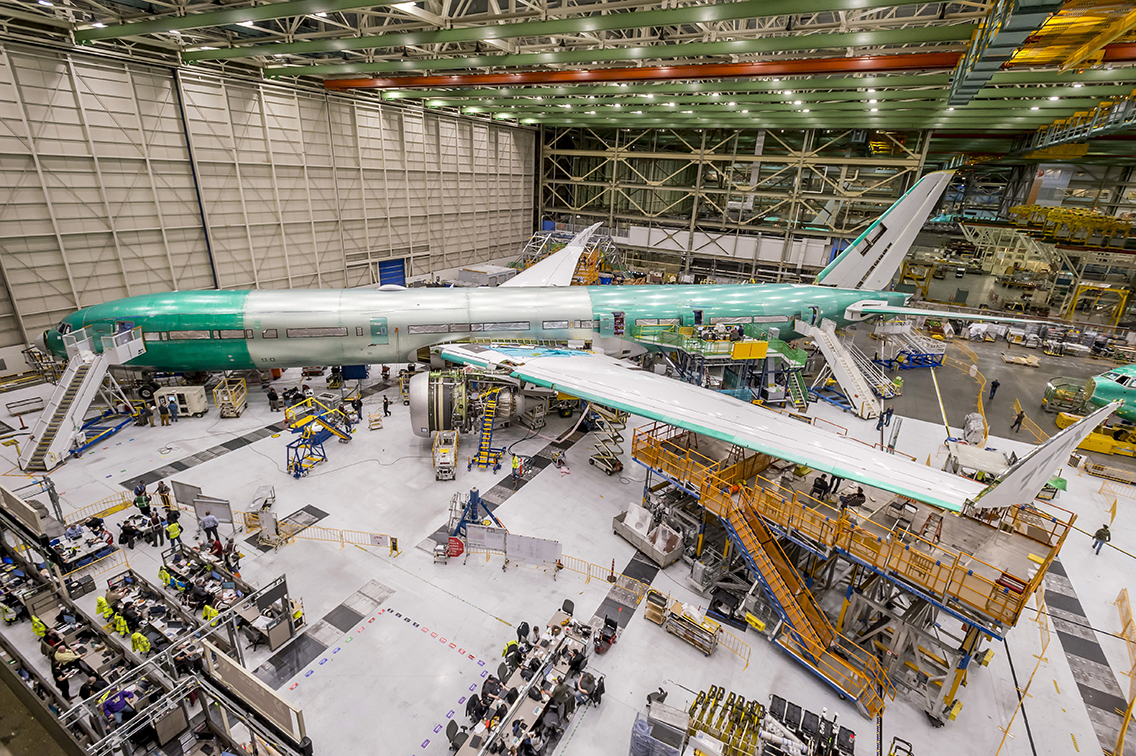Leeham News and Analysis
There's more to real news than a news release.
Boeing’s 777X analyzed, Part 4
By Bjorn Fehrm
Subscription Required
Introduction
March 07, 2019, © Leeham News: In our analysis series about the Boeing 777X, it’s time to look at the performance of the 777-9 and 777-8 and compared them to their main competitor, the Airbus A350-1000.

Figure 1. First flight test Boeing 777-9 with the GE9X engines mounted. Official roll-out is set for March 13th. Source: Boeing.
Summary:
- The 777-9 is a larger and heavier aircraft than the A350-1000. Its wide wing and efficient engines compensate the added weight when compared with the A350-1000. Both have best-in-class fuel efficiencies.
- The “cut and shut” 777-8 has the same capacity as the A350-1000. Here the wings, engines and empennage from the 777-9 give it Ultra Long Haul capabilities. In normal route use, this capability weighs on its fuel efficiency.
Rolls cites timing, analysts cite poor financial condition for NMA withdrawal
Subscription Required
Introduction
March 4, 2019, © Leeham News: Rolls-Royce last week announced it had withdrawn from competition for the Boeing NMA engine provider, citing a  mismatch in timing between its Ultra Fan being ready and Boeing’s desired entry into service.
mismatch in timing between its Ultra Fan being ready and Boeing’s desired entry into service.
Warren East, the RR CEO, glossed over other reasons, but they were there: the program making commercial sense and the impact of the Trent 1000 engine challenges.
Aerospace analysts interviewed by LNA and whose research notes were provided have other reasons.
Summary
- After dissecting RR’s financial statements, with special charges, accounting changes and Free Cash Flow analysis, some analysts concluded the company simply doesn’t have the money to develop the engine for the NMA.
- Although CEO East glossed over the Trent 1000 issues, some analysts feel this was more important than let on.
- CFM, according to one analyst (and many observers), believes it is the favorite for the NMA engine selection, so RR bowed out.
Shareholders OK Boeing-Embraer JV; court, anti-trust approvals next
Subscription Required
Introduction
Feb. 28, 2019, © Leeham News: Embraer’s shareholders this week approved the joint venture between their company and Boeing, moving another step closer to completion expected by the end of this year.
Boeing will own 80% of the new company and have governance control; Embraer will own 20%.
The shareholders’ action comes after a Brazilian court for the fourth or fifth time enjoined the companies from proceeding with negotiations. Higher courts overturned each previous injunction and will likely do so again.
Global regulatory anti-trust reviews are the step. All decisions are expected by year end.
John Slattery, CEO of Embraer Commercial Aviation, gave this take on the pending joint venture in his column on LinkedIn.
Summary
- “NewCo” will be based in Brazil and be responsible for Boeing’s commercial airplanes up to 150 seats.
- A second joint venture is planned for military development.
- The KC-390 is a focus of the second JV.
Airbus appears poised to launch A321XLR
Subscription Required
Introduction
Feb. 25, 2019, © Leeham News: The longer Boeing dithers on launching the New Midmarket Airplane, the harder it is to close an already difficult  business case.
business case.
News last week that Airbus finally, at long last, is appears about to launch its Xtra Long Range A321XLR this year is overdue. Doing so will make Boeing’s NMA business case more difficult to close.
The aircraft should have been launch in late 2017, an insider told LNA recently. But the corruption scandals enveloping Airbus disrupted plans and drove executives to indecision. Launching the A321XLR was put on hold.
Summary
- Killing the NMA.
- A321XLR details.
- Narrow market.
- Engine down select soon.
Airbus, Boeing pause on some production rate hikes
Subscription Required
Introduction
Feb. 21, 2019, © Leeham News: Airbus is boosting the A320 production to 60/mo this year and 63/mo next year.
But it’s put a pause on increasing the A350 rate from 10/mo to 13/mo.
Boeing was widely expected to follow its planned 737 rate hike of 57/mo, from this summer, to 63/mo next year to keep up with demand and with Airbus.
However, on the sidelines of the annual Pacific Northwest Aerospace Alliance conference last week, LNA learned that a 737 rate hike to 63/mo has been apparently put on a pause. Although Boeing has not made a decision to go to rate 63, the hike was expected in 2021, according to suppliers. This is now showing as 2022, they said.
Summary
- Airbus, Boeing backlog for single-aisle airplanes extends years.
- Both have ramped up production to meet demand, create delivery positions.
- Supply chain struggles to keep up.
- Twin-aisle demand waits for replacement surge.
A380 end opens opportunity for A350-2000
Subscription Required
Introduction
Feb. 18, 2019 © Leeham News: Airbus’ decision to end the A380 program clears the path, if chosen, for a plane that was studied three or four years ago: the stretch of the A350-1000 to the size of the 777-9.
A 400+ passenger “A350-2000” would have encroached too closely on the A380’s 500+ passengers. Officials feared the A350-2000 would hurt the sales prospects of the A380.
With the A380’s last delivery now planned for 20xx, this becomes a moot point.
The prospect of a new, Rolls-Royce Ultra Fan engine for the A350 around 2025 will give the -2000 significantly superior economics to the 777-9 and a longer range, a preliminary analysis by LNA shows.
Summary
- An A350-2000 with RR Ultra Fan engines is superior to the 777-9.
- However, Boeing has a big head start with orders for 340 777Xs, most of which are for the -9.
- The market demand for a 400-450 seat airplane is increasingly iffy.
- But the A350-900/1000neo helps business case.
Read more
A simple solution to congested skies
By Dan Catchpole
Danieljcatchpole[at]gmail[dot]com
Subscription Required
Introduction
Feb. 14, 2019, ©. Leeham News: Flight delays cost the airline industry

Traffic back ups are increasing–so much so that Airbus has invested in improving air traffic management to avoid congestion affecting aircraft sales.
billions of dollars each year. They cause travelers untold aggravation and inconvenience every day. And the main culprit—air traffic congestion—is only going to get worse as Boeing and Airbus deliver tens of thousands of jetliners over the next couple decades.
Regulators, lawmakers and the aviation industry in the United States have settled on spending billions of taxpayer dollars on NextGen—after having already spent billions—to implement complex technical solutions to keep the skies safe and cut down on flight delays.
The Federal Aviation Administration (FAA) estimated in 2017 that implementing NextGen will cost roughly $35.7 billion by 2030–$20.6 billion from the FAA and another $15.1 billion from the aviation industry.
NextGen has moved with the swiftness of a sprawling, technocratic federal program—that is to say like an elephant at the ballet. It has endured delays and cost escalation, though these have not been crippling. However, it is years away from unclogging America’s congested air spaces.
Moreover, there are very real questions as to whether NextGen will be able to deliver all the FAA promises it can.
Summary
- Air spaces are getting more crowded, leading to greater flight delays.
- Airbus is concerned that congestion could hurt demand for jetliners, and is taking steps to improve air traffic flow.
- Substantial questions exist as to NextGen’s ability to unclog air traffic congestion.
- Taking a system-wide approach that taps into airlines’ desire to maximize profits could be implemented now, say proponents.
Boeing’s 777X analyzed, Part 3
By Bjorn Fehrm
Subscription Required
Introduction
February 07, 2019, © Leeham News: In our analysis series about the 777X, we have now come to the smaller member of the 777X, the 777-8.
It’s what’s called a “cut and shut” shrink of the main variant, the 777-9. A cut and shut derivative of a larger base aircraft gives the smaller aircraft some special characteristics. We look at what this entails.
Summary:
- The 777-8 is a “cut and shut”variant of the 777-9. This means it keeps the wings, engines, landing gear and empennage of the larger 777-9.
- A shorter fuselage with a reduced cabin size means the 777-8 filled with passenger and cargo has more weight margins for fuel within the same Maximum Takeoff Weight as the 777-9.
- The end result is an Ultra Long-haul capable aircraft, available from 2022.
Countdown to NMA decision, Part 4: Time out
Subscription Required
Feb. 4, 2019, © Leeham News: It’s time for Airbus to launch the A321XLR.
Boeing last week announced a program launch for the New Midmarket Airplane won’t come until 2020 at the earliest.
Authority to Offer (ATO) may come as early as March or April. It had been widely expected a program launch would be announced at the Paris Air Show in June.
Airbus has been mulling the XLR launch since 2017. Inside information says a November 2017 launch was planned when all the distractions over the corruption scandals, coupled with key executive retirements, overwhelmed events.
Fifteen months later, Airbus dithers while Boeing vacillates.






